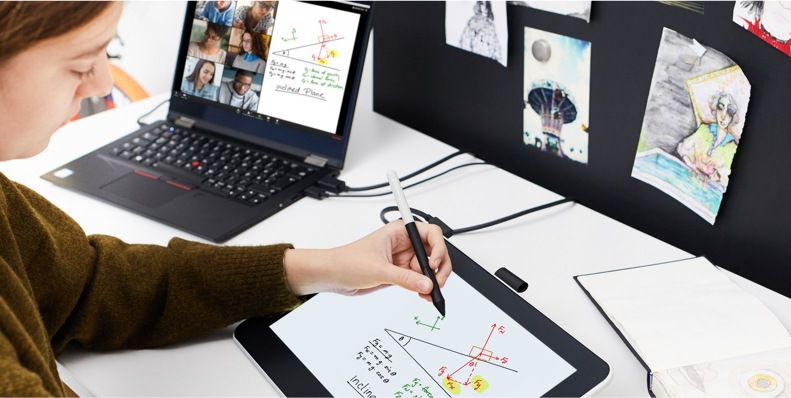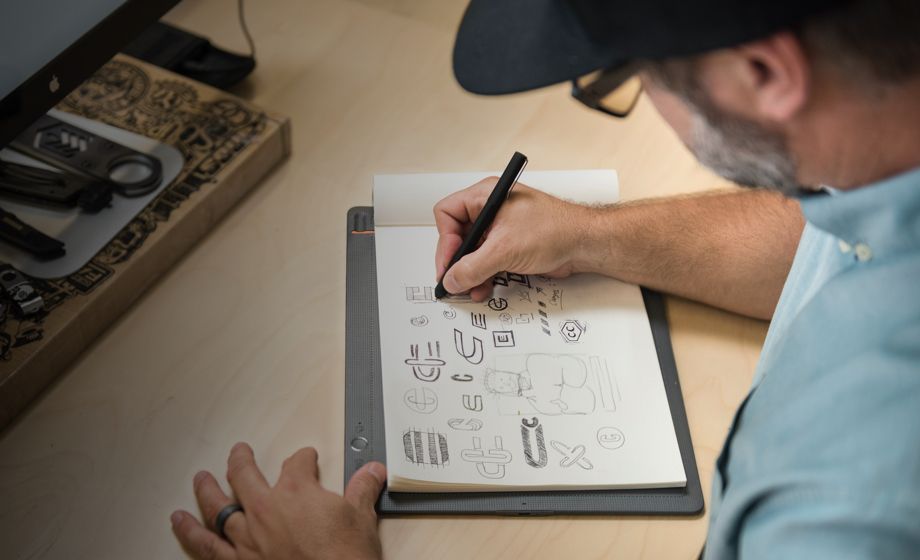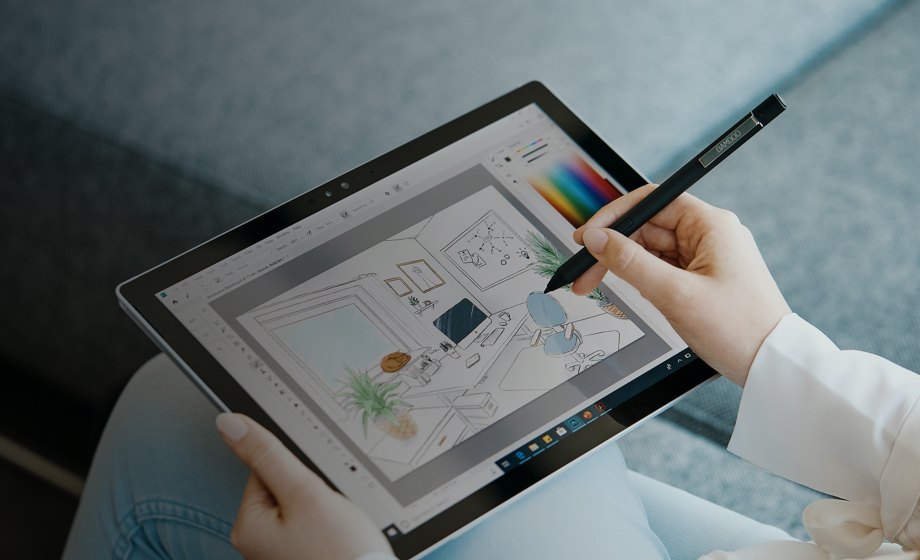Pen tablets
Esboza, dibuja y edita imágenes usando una tableta con gran capacidad de respuesta y un lápiz preciso, y observa cómo tus creaciones aparecen en pantalla.


Las posibilidades creativas de una colaboración eficaz son infinitas. Nuestras ideas son siempre mejores cuando se comparten y perfeccionan con los demás. Tanto si se trata de ajustar estrategias como de desarrollar ideas iniciales sobre nuevos proyectos, podemos ser mucho más creativos en nuestro enfoque cuando lo hacemos juntos.
Entonces, ¿qué aspecto adopta la colaboración creativa cuando el trabajo a distancia y el aislamiento son obligatorios? ¿Se vuelve menos eficaz? No necesariamente. Las videollamadas y las sesiones virtuales de intercambio de ideas pueden ser igual de buenas para desarrollar ideas y perfeccionar proyectos, como muestran estos prácticos principios y consejos.
Entonces, ¿qué aspecto adopta la colaboración creativa cuando el trabajo a distancia y el aislamiento son obligatorios? ¿Se vuelve menos eficaz? No necesariamente. Las videollamadas y las sesiones virtuales de intercambio de ideas pueden ser igual de buenas para desarrollar ideas y perfeccionar proyectos, como muestran estos prácticos principios y consejos.

Puede parecer un reto organizar una videollamada de un grupo grande. La buena noticia es que los servicios están diseñados para que los puedan usar varias personas y existen innumerables técnicas para garantizar la implicación y participación de todos. Por un lado, a diferencia de una llamada normal, la tentación de la multitarea es mucho menor. Al fin y al cabo, los compañeros podrán verse unos a otros cogiendo el teléfono o mirando al otro lado de la habitación.
Tras lograr que todos se unan a la llamada, asegúrate de saludar a cada persona por turnos. Si ya se ha compartido un orden del día por correo electrónico, conviene fomentar el uso de herramientas de chat dentro de la videoconferencia para ayudar a compartir pensamientos y formular preguntas, en lugar de interrumpir el discurso de alguien.
Esto también puede ser eficaz cuando se discute un problema o tema concreto. Haz una pregunta a todos los participantes en la llamada y, en lugar de que cada uno de ellos dé su respuesta a viva voz, haz que envíen sus respuestas por el chat durante una rápida pausa de cinco minutos. De este modo, la persona que preside la reunión puede compartir las ideas una vez cotejadas, antes de discutirlas en grupo.
La clave es hacer que todos los participantes en la llamada se impliquen y sientan que tienen algo que aportar. En este sentido, el poder del lenguaje corporal para levantar la moral resulta vital. Un asentimiento con la cabeza o un pulgar hacia arriba puede ser un estímulo. Esto hace que la llamada y la interacción sean más transparentes y humanas.
El mejor software de videoconferencia no solo te brinda la oportunidad de hablar con tus compañeros cara a cara. También te permite compartir y anotar tu pantalla en tiempo real. Esto puede ser especialmente útil al trabajar en una presentación o en un nuevo proyecto. Aprovecha al máximo las pen tablets y monitores punteros de Wacom para rodear o subrayar las partes de un documento de las que estés hablando. Y anima a los demás a que compartan sus pantallas a su vez para que todos puedan visualizar el tema de conversación mientras lo discuten.
Esto puede hacer que las videollamadas sean tan productivas como una reunión en la oficina. Los participantes en la llamada pueden ver lo que se discute en tiempo real y profundizar en documentos, presentaciones o notas en pantalla a medida que avanza la reunión, pudiendo así proponer soluciones e ideas mientras discurre la conversación.
Del mismo modo, se puede trabajar en documentos compartidos mientras se realizan las llamadas, lo que permite que todos plasmen sus pensamientos e ideas en un mismo lugar. Así, todos podrán acceder fácilmente a ellos una vez finalizada la reunión.

Las sesiones de lluvia de ideas pueden desviarse fácilmente en la oficina y es igual de probable que lo hagan en un entorno de trabajo a distancia. La buena noticia es que unas cuantas reglas sencillas pueden ayudar a que sean muy útiles. En primer lugar, asegúrate de utilizar plataformas específicas de lluvia de ideas en línea que permitan una fácil colaboración visual.
Lo más importante es que una persona actúe como moderador, dirigiendo la sesión y centrándose en mantener las actas para la acción posterior. Antes de empezar, esta persona debe enviar el tema que se va a debatir y establecer un límite de tiempo, idealmente más de un día, para que los participantes en la convocatoria aporten ideas. Estas deben considerarse en solitario, y no compartirse con el grupo antes de la convocatoria, a fin de garantizar que se escuche la voz de todos.
Durante la llamada, establece un límite de tiempo para que cada persona exponga sus ideas. Se pueden añadir a una herramienta de pizarra virtual. Una tableta de dibujo hará que este proceso sea aún más fácil y natural. Una vez que estén todas las ideas, fija un límite de tiempo para debatirlas. Después de la reunión, las acciones deben compartirse mediante una herramienta de chat de grupo, lo que permite a todos comprender los siguientes pasos y lo que necesitan para llevarlos a cabo. El hecho de que la gente pueda marcharse y trabajar individualmente en las tareas que se le han encomendado hace que este enfoque sea mejor que en la oficina, donde otros proyectos de trabajo pueden servir de distracción.
Producto recomendado

Wacom One 13
Dibujar, diseñar y crear directamente en una pantalla de alta resolución con un lápiz preciso.

Esboza, dibuja y edita imágenes usando una tableta con gran capacidad de respuesta y un lápiz preciso, y observa cómo tus creaciones aparecen en pantalla.

Dibuja, diseña y crea directamente en una pantalla de alta resolución con un lápiz preciso.


Escribe y anota rápidamente ideas en tu dispositivo móvil con un lápiz digital Wacom.
La estrategia de Wacom consiste en acercar la tecnología a las personas mediante su tecnología de interfaz que hace que la experiencia al usarlo se sienta natural. Esto ha convertido a Wacom en el fabricante líder a escala internacional de pen tablets y pantallas interactivas, así como de lápices digitales y soluciones para guardar y procesar firmas digitales. La tecnología avanzada de los dispositivos Wacom es Intuitiva y se ha utilizado en la creación de algunas de las películas, efectos especiales, moda, diseños y obras de arte digitales más interesantes del mundo, y ofrece a los usuarios domésticos y profesionales una tecnología de interfaz líder para expresar su propia personalidad. Fundada en 1983, Wacom es una compañía global con sede en Japón (bolsa de valores de Tokio: 6727), con filiales y sucursales en todo el mundo para cubrir operaciones de marketing y distribución en más de 150 países.